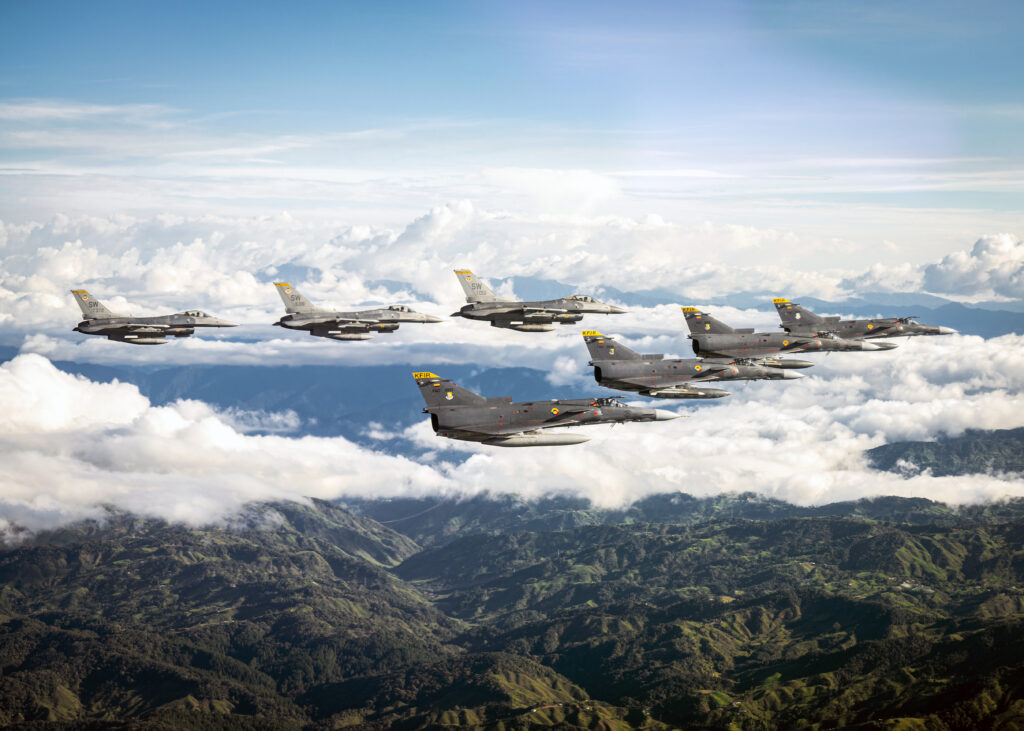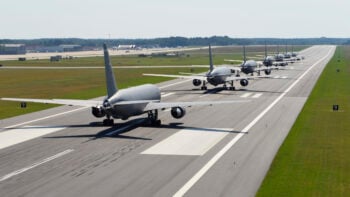
F-16 Fighting Falcons assigned to the 79th Expeditionary Fighter Squadron and Colombian Air Force Kfirs fly in formation over Colombia during Exercise Relampago VI, July 27, 2021. USAF)
WASHINGTON: Spurred in part by a potential sale to Columbia of F-16 fighters, the Defense Department is considering novel ways for cash-strapped allies and partners to finance a buy US weapon systems — by bolstering the ability of domestic industry to compete, an Air Force international sales expert said today.
Although she hasn’t “finalized her thinking,” Heidi Grant, director of the Defense Security Cooperation Agency (DSCA), “is looking at ways that we can compete … more creative financing options for for partners,” said Col. Anthony Walker, senior materiel leader in the International Division of the Air Force Security Assistance and Cooperation Directorate (AFSAC). AFSAC, part of the Air Force Life Cycle Management Center, is one of three implementing agencies for DoD Foreign Military Sales (FMS).
“With a lot of partners, they’re asked us to provide funding up front before we actually can execute the contract,” he explained in a briefing with reporters. “But maybe there’s some changes that might be coming out of DSCA at some point that can address that, and perhaps do some things differently in the future.”
One option for countries like Colombia, which don’t have a “giant national budget,” could be a third-party transfer from a different country with a current fleet of older F-16s that is buying replacement jets, Walker elaborated. “It’s a way for the country to get started,” he said, and that initial buy could perhaps be augmented with new ones over time as funds free up.
“I was recently in a meeting with Ms. Grant, [and] we are going to take a stronger look at how we’re advertising to partners what the third-party transfer menu looks like. In the coming months, I think we’re going to be working on a better way to share that with our partners, so that they know what’s available,” he added.
“We do have different programs available for aircraft that the US Air Force is is done flying,” he added. “We can take aircraft out of the boneyard, refurbish it and provide that to a partner; we’ve done that, numerous times in the past few years.”
Or, the Air Force can directly transfer aircraft that are going out of service to a foreign partner, before they are mothballed at the Davis-Monthan Air Force Boneyard in Tucson.
“When we’re ready to offload C-130s that we’re no longer flying, we’re able to transfer those to foreign partners as well and they call that the ramp-to-ramp program,” Walker said. “So, yeah, you know, we’re, we’re constantly scanning the environment for what we can offer and what we, and what partners are looking for in terms of demand.”
Walker noted that the F-16 is often a “platform of choice” for foreign countries looking for fourth-generation fighters. For example, Austria in March asked the Air Force for pricing and availability information. (Austria has been dithering since 2017 about replacing its aging Eurofighter Typhoons.) The service also is “seeing interest” in the Indo-Pacific region, including from Taiwan, and “even in South America” — i.e. Colombia, which expressed interest back in 2019.
“We are seeing quite a bit of interest in the F-16 across the world,” he said.
Walker explained that unlike some competitor nations on the international marketplace who “are dare doing things that potentially might not even be in the best interest” of the buying nation, the US takes what is called a “total package approach” to ensure a partner nation can sustain the aircraft it buys.
“We want to make sure that they’ve got sufficient infrastructure to be able to support the systems that we’re selling them; that they have sufficient spares and supplies and things of that nature; sufficient training. Some of our competitors don’t look at things that way,” he said. This means the up-front price is cheaper, but in the long run the deal is not as good.”
Army inching towards late FY25 Chinook Block II full-rate production contract
Boeing recently announced the Block II helo’s first maiden flight and plans to deliver the first production aircraft to the service in the coming weeks.


























